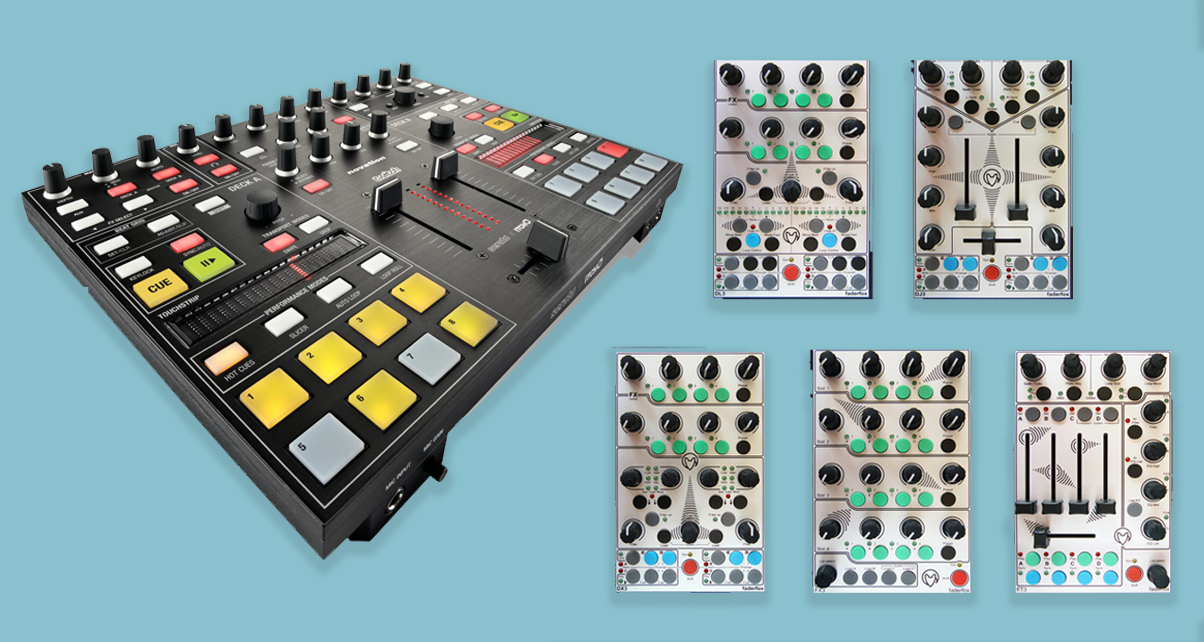Making the jump from a controller to using CDJs for the first time can be a bit intimidating, but it’s not as hard as it used to be: Modern DJ controllers like the Pioneer DJ DDJ-400 or the Roland DJ-202, share a similar layout to the CDJ set-up that you’ll find in club and bar booths.
How did DJ controllers get to this?
In digital DJing’s “wild west” past (circa 2000-2010), controllers came in all sorts of designs, orientations and layouts. Most were compact devices (like those from Faderfox and Behringer) that had jogwheels and a mixer, with buttons, pads, knobs and faders laid out across their faces.
Some controllers, like the Novation Twitch (and then the Native Instruments Traktor Kontrol S8), eschewed jogwheels altogether, while some DJs even preferred to spin using keyboard and pad controllers mapped to their DJ software. There was a “frontiersman” vibe to the early days of digital DJing back then.

The introduction of the original Traktor Kontrol S4 in 2010 and then the Pioneer DJ DDJ-SX in 2012 ushered a gradual shift towards a more homogenised look for DJ controllers: two jogwheels, a mixer in the centre, pads under each jogwheel, and effects at the top.
Both were runaway successes for their respective companies, and their influence continues to linger: Native Instruments’ latest flagship offering is a “Mark 3” version of the Kontrol S4 (coming from a lukewarm response to its Kontrol S8 / S5 / D2 and STEMS format), while every controller Pioneer DJ has made since then inherited the DDJ-SX layout up until the DDJ-1000 last year. The DDJ-1000 is an even closer mimicry of a CDJ/DJM set-up thanks to the positioning of its looping controls and effects.
Although many features are similar, there are some key differences that you should be aware of before using CDJs for the first time:
1. Performance pads versus hot cues
Instead of performance pads found below the jogwheel, CDJ hot cues can be found in the upper left of the unit. While the latest CDJ-2000NXS2 has four hot cue buttons, older CDJs such as the CDJ-2000Nexus only have three. Furthermore, these buttons only serve one function: to trigger and add hot cues, unlike performance pads that can have a variety of functions depending on which pad mode you’ve got enabled.
This also means that, unfortunately, if you like using performance pad modes like Slicer, Pad FX, and Keyboard, you won’t find them on a CDJ. If you’re spinning with a laptop connected via HID Mode, you’ll have to trigger them via your laptop’s keyboard or mouse.
2. Library and playlist browsing
One of the best things about DJing with a laptop is the ease and speed with which you can browse your library: you’ve got a full-size tactile keyboard and a huge screen that you can use to search for tunes and to even make playlists on the fly. It’s a bit more difficult with CDJs because you have to scroll through your collection using a knob (plus an onscreen Qwerty keyboard if you’re using a touchscreen CDJ / XDJ unit). And since the screen size is relatively tiny compared to a laptop, you’re only able to see a handful of songs at any one time.
That means you’ve got to be extra organised when it comes to your music and playlists – you don’t want to waste time scrolling through a messy playlist with (god forbid) hundreds of songs. Sure, you can hold down the Browse knob to turn on a “quick search” mode that allows you to scroll through the selected playlist faster, but your time would be better spent preparing ahead of the gig and segmenting that massive playlist into smaller ones.
3. Jogwheel tension adjust knob
You can change how stiff or loose the jogwheel is on a CDJ-2000NXS2 via the Jog Adjust knob, which can be useful if you are particular about how tight you want the jog to be when you’re scratching. Conversely, you can also loosen it all the way and spin the jog in reverse to get that classic “UK Spinback” effect. Most DJ controllers don’t have this feature, though it can be found on flagship devices like the DDJ-RZ and the DDJ-1000.
4. Track search / restart
When cueing up your next track, sometimes you want to jump back to the very beginning of the song – for example, you’re trying to beatmatch and you can’t quite nail it yet. DJs like having this ability because it lets them quickly redo a mix, or they simply want to move back to the start fast. On a controller, this is usually done using a shift function or pressing Cue / a hot cue pad.
On a CDJ, there’s also a dedicated button for bringing the track back to the very start: Hit the left “Track Search” button to jump back to the beginning of the current track. You can also press the Cue button if you’ve got a cue point set at the beginning of the song.
Finally…
Switching to CDJs from a controller is easier than it used to be, although you should still be aware of the differences that we’ve listed here. Once you’re familiar with them, you can take command of club set-ups with greater confidence instead of panicking and looking for where certain features are and wondering why they don’t seem to work the way you want them to.
What other CDJ nuances should controller DJs be aware of? Any tips you’d like to share for transitioning to CDJs? Let us know below.




